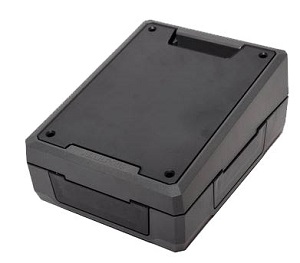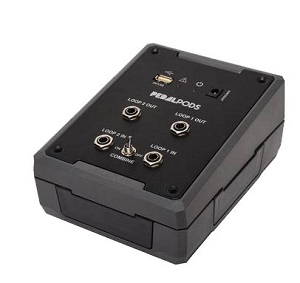Become a Pedalboard Mod God with Pedal Pods
trushack | Sep 26, 2019 | Comments 0
Modular Construction, Integrated Power, and Signal Tweakability Make Pedalboard Customization Easy!

This writer remembers a time, not long ago at all, when guitarists (and even some bassists) were stuck using one pedalboard to do everything. Some of us had the trusty ol’ Boss three- or six-slot “briefcase” and were forced to devise crazy ways to get our non-Boss pedals to fit. Others grabbed a piece of plywood, painted it black, and jammed whatever they could on it. There were no “fly rigs” or special studio boards; you rolled with what you had…if you had a board at all!

Pod
That ol’ Boss briefcase is still around, and plenty of other builders have made exciting refinements to the typically staid pedalboard platform but there is one company, Pedal Evolution, that has developed a pedalboard system that covers every base you can think of, including expansion: the Pedal Pod pedalboard system. The Pedal Pod pedalboard system is a modular system that uses large, durable, rectangular “pods” with integrated connectors, along with a lot of other clever features you might not expect, that make switching up, slimming down, or expanding you pedalboard set-up super-easy.
The hub of the Pedal Pod system is the Gas Pedal. Instead of hosting a pedal, it provides the primary connection for your guitar and amp, supplies power to the Pedal Pods, lets the player select between the two available signal loops (which we’ll cover a little further down, so keep reading), and even provides a fully isolated USB power source for charging peripheral devices or even adding pedalboard lighting.

Gas Pedal
The Gas Pedal and Pedal Pods, which host one full-sized pedal or two mini-pedals each, can accommodate your preference of mounting materials (Velcro, 3M Dual Lock, or even screw-based mounts), links to the other(s) by way of an internal “keystone” locking system. You can connect Pedal Pods horizontally or, using the available riser pads, in rows of two. You could even go one full row with one half row on top if that’s your thing to cut weight and not deal with the wasted space that would come with a standard, non-configurable pedalboard. The bottom of each Pedal pod features durable, non-slide padding to keep things solidly in place on stage and studios and they are rugged enough that you can literally drive a truck over them (check out the photo gallery here.
Each pedal hooks into its respective Pedal Pod through two included patch cables and receives reliable, high-current power via an included power cable, with the amount of voltage required selectable between 9,12, 15, and 18 volts. The Pedal Pods themselves then all connect to one another via analog CAT5 cables (there’s nothing digital in the Pedal Pod system). So if you find yourself moving you Pedal Pods around, the connections to the pedal itself don’t need to be touched; you simply open the hood, disengage the CAT5 connectors, unlock the keystones, re-configure the board, and then re-connect the CAT5s. There are no patch cables or power cords to un-tangle and then…ummm…re-tangle?
The Tone King and I first met Rick and Jerry from Pedal Evolution at Summer NAMM 2019, where they had the Pedal Pods on display and ready to rock. A couple of gear industry titans had apparently also taking notice with one major company that has made a name for itself in the pedal business commenting to the Pedal Pods guys that (paraphrased) they had been trying to figure out a modular pedalboard solution for years. Another gear industry figure, who has actually been featured quite a bit on TheToneKing.com and shares a name with a certain Godfather of Soul, noted that he had never heard a pedalboard rig so quiet. This writer’s honest first impression was, “OK, cool. You can essentially build your own custom pedalboard as big or as small as you like, and all of the cables are stowed underneath giving everything a clean look. Plus, it’s got a flexible voltage in the power supply. Interesting stuff.”
What I didn’t expect was all of the additional, useful features built-in to the system.
“Wait, there’s a switchable buffer?” Yes! Audiophile-quality op-amp buffers, in fact!
“But there’s no way there’s built-in noise reduction?” Believe it or not, yes!
“And there’s an option to run different pedals in separate loops?” You can do that also!
In this writer’s book on pedalboards, Rick and Jerry really thought of everything. There are even 14 patent claims associated with the Pedal Pods system, which gives you a further idea of how innovative and special this gear really is. Having used pedals that required different voltages unable to be supplied by some pedal power providers, experimented with stand-alone buffers, and attempted to set up a clean and simple parallel chain for an electric 12-string on the same pedalboard as my normal rig (which just made things more complicated), I was immediately impressed that all of these things had been considered, as well as cleverly implemented, into the Pedal Pod system.
Below the plate, in the same spot where all the keystones, are the loop connections alluded to earlier in the article. It’s a set of four jacks, one set of in/outs for Loop 1, and another set for Loop 2. Why two loops and not a single in/out? Let’s take a look at one scenario: say you run a normal six-string electric for part of your set but, for a couple of tunes, switch over to an acoustic that runs through a preamp pedal and a few other effects into an acoustic amp or front-of-house DI.

Multi-Tier Board with Risers
You can set up a second row of pedals dedicated to the acoustic, set that row as Loop 2, and then engage that loop via the selector switch on the Gas Pedal when it’s time to get strummy and sensitive. No separate power supply, no separate board, no plugging and unplugging your acoustic (just leave everything in the Loop 2 jacks on the Gas Pedal) and your acoustic signal chain stays out of the way, both physically and electronically, until you need it. Pretty cool, very convenient, and an echo of the flexibility provide by the modular nature of the Pedal Pod system. Or, since you can engage both loops simultaneously, you can configure the inputs and outputs from both loops to run a true stereo rig. You could get really wild and set-up two completely different pedal and amp rigs entirely and seamlessly move between both with the flick of a switch.
The activation switches for the other functions are assembled there as well, and easily accessible whether your custom Pedal Pod pedalboard is assembled or not. Just lift the hood, make the adjustments as needed, re-secure and go. You can experiment with buffering in different parts of the chain or easily develop work-arounds for persnickety pedals like fuzzes, which sometimes don’t play well with buffers.
The built-in noise reduction is not by accident, but the result of extensive testing by the Pedal Evolution team. Rick and Jerry worked as hard to get the system to reject interference from nearby electronic sources which often insert ghosts and cackles into even the most carefully assembled signal chains. Using a large ground plane and capacitor isolation design enables the Pedal Pod system to organically eliminate much of the interference players would typically use an external noise gate or suppressor to take care of.

Scale down to a Gig-Rig!
All of the internal electronics are “floated” and the Pods are vented so that any moisture that might intrude into the Pedal Pods, perhaps from an errantly position Michelob Light, drains right out instead of collection in the bottom and spoiling the system. And if you want to get stylish or, like this writer, want to give your aging eyes a hand, translucent panels are available to take advantage of the internal LEDs installed in each Pedal Pod. Even better, players can select among four different LED colors and adjust their brightness. You can assign certain effects certain colors for quick location on the fly or just give yourself something pleasant to look at if you’re the shoe-gazing type.
Last but not least, you can add a handle to your Pedal Pod system for handy transportation. Yup, they thought of that, too. They’ve even got the players who have all of their buffering and powering needs accounted for covered but still want to take advantage of the modularity; Pedal Pods can be ordered “empty,” that is, no inputs, buffering, or power connections. The stripped-down Pedal Pod models are also a perfect option for “workstation” pedals that might be larger than the standard Pedal Pod but only require one set of electronics to function.
All of the features just described would be fantastic even in a pedalboard that you can’t adjust the size and layout of.The Pedal Pod’s modular system means that no matter how your effects needs change, you don’t have to start from scratch, reconsider your power supply needs, or worry about the quantity and length of whatever additional cables you need. The Pedal Pod has you covered, so you can just get out there and play.
Check out The Tone King and Jerry from Pedal Evolution, Live on YouTube!
Tiny URL for this post:
About the Author:




















